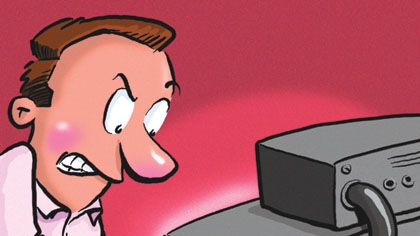The electronic padlock

It seems that the EBU is following an example set by the U.S. Consumer Electronics Association by moving rapidly to prevent consumers and viewers from misappropriating content. Of course, the vendor, not the consumer, will set the definition of misappropriation.
The EBU is following up on a study group report taken three years ago, which set forth general standards for the protection of intellectual property (TV programs). While the discussions were initially specific to cable, the potential for widespread use (abuse) is obvious. The Watermarking process is being pushed for widespread adoption by the EBU in support of the demands of content makers.
The idea of an electronic lock on content stems from the paranoia by Hollywood and other content makers that without a perfect digital control system on every video, TV program, song and Internet page, consumers might get something for free. The whole idea of Free-to-air TV is about to die a rapid death from this digital bullet.
The USA is ahead (if you agree this is good) of Europe in implementing this electronic lock on every TV in the country. Last month, a consortium of equipment manufacturers and content makers announced the specifications for these new technical interfaces, which will be used to interconnect consumer entertainment devices.
There are basically two interfaces being suggested, IEEE 1394 (Firewire) and DVI (Digital Visual Interface). In round numbers, 1394 will currently provide about 400 Mbytes/s throughput. That's adequate to support 480p resolution, PAL and NTSC images. However, it will not handle 720p or 1080i signals. That's where DVI comes in. That interface will support all resolutions from NTSC to HDTV.
Using High-bandwidth Digital Content Protection (HDCP) and Digital Transmission Content Protection (DTCP) schemes, any program deliverer, content maker or supplier will be able to control not only the access to the program, but even adjust the display resolution on the TV set or monitor in the consumer's home.
The keystone to this invasion into the home, especially in Europe, lies in the set-top box (STB). Soon, through a pay-per-view or even pay-for-quality option, you could be charged by the resolution you choose to watch a program. And, you certainly won't be able to record (for free) that HD program, no matter what blue laser DVD recorder you have.
The professional video industry's #1 source for news, trends and product and tech information. Sign up below.
The consumer electronics industry will soon begin installing these digital interfaces on DVD players, TV sets and monitors. While analog outputs and inputs will remain, these outputs will process only low-resolution images — not high-definition signals. Without a complete DVI output/input connection, viewers won't be able to view the very HDTV content they paid thousands of dollars to receive. Once DVI technology is used to control access to HDTV and other high-end content, perhaps 5 million very expensive TV sets and HDTV monitors will become essentially worthless.
While these changes will drastically affect consumers, they also will impact broadcasters. The need to deliver a secure link, complete with embedded content protection signals, will force broadcasters into a world they've never known. This means new demands on facility construction, operator training and security. Fortunately, Broadcast Engineering will be there to help and provide answers. Stay tuned.
Send comments to: • direct:editor@primediabusiness.com• web site:www.broadcastengineering.com
